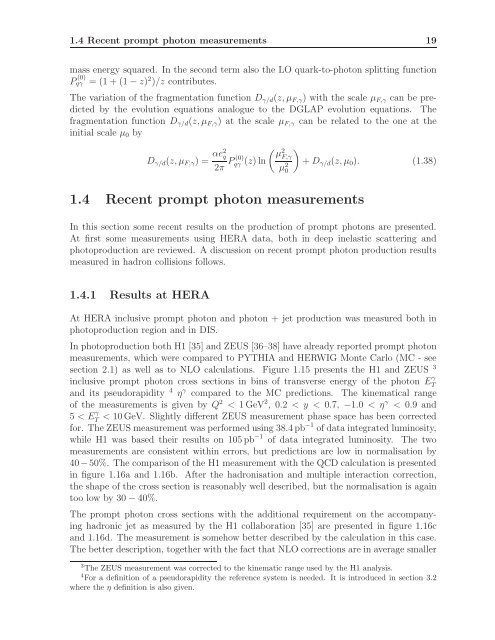10 - H1 - Desy
10 - H1 - Desy
10 - H1 - Desy
You also want an ePaper? Increase the reach of your titles
YUMPU automatically turns print PDFs into web optimized ePapers that Google loves.
1.4 Recent prompt photon measurements 19<br />
mass energy squared. In the second term also the LO quark-to-photon splitting function<br />
P (0)<br />
qγ = (1 + (1 − z) 2 )/z contributes.<br />
The variation of the fragmentation function D γ/d (z, µ F,γ ) with the scale µ F,γ can be predicted<br />
by the evolution equations analogue to the DGLAP evolution equations. The<br />
fragmentation function D γ/d (z, µ F,γ ) at the scale µ F,γ can be related to the one at the<br />
initial scale µ 0 by<br />
(<br />
D γ/d (z, µ F,γ ) = αe2 q µ<br />
2<br />
)<br />
2π P qγ (0) (z) ln F,γ<br />
+ D<br />
µ 2 γ/d (z, µ 0 ). (1.38)<br />
0<br />
1.4 Recent prompt photon measurements<br />
In this section some recent results on the production of prompt photons are presented.<br />
At first some measurements using HERA data, both in deep inelastic scattering and<br />
photoproduction are reviewed. A discussion on recent prompt photon production results<br />
measured in hadron collisions follows.<br />
1.4.1 Results at HERA<br />
At HERA inclusive prompt photon and photon + jet production was measured both in<br />
photoproduction region and in DIS.<br />
In photoproduction both <strong>H1</strong> [35] and ZEUS [36–38] have already reported prompt photon<br />
measurements, which were compared to PYTHIA and HERWIG Monte Carlo (MC - see<br />
section 2.1) as well as to NLO calculations. Figure 1.15 presents the <strong>H1</strong> and ZEUS 3<br />
inclusive prompt photon cross sections in bins of transverse energy of the photon E γ T<br />
and its pseudorapidity 4 η γ compared to the MC predictions. The kinematical range<br />
of the measurements is given by Q 2 < 1 GeV 2 , 0.2 < y < 0.7, −1.0 < η γ < 0.9 and<br />
5 < E γ T<br />
< <strong>10</strong> GeV. Slightly different ZEUS measurement phase space has been corrected<br />
for. The ZEUS measurement was performed using 38.4 pb −1 of data integrated luminosity,<br />
while <strong>H1</strong> was based their results on <strong>10</strong>5 pb −1 of data integrated luminosity. The two<br />
measurements are consistent within errors, but predictions are low in normalisation by<br />
40 −50%. The comparison of the <strong>H1</strong> measurement with the QCD calculation is presented<br />
in figure 1.16a and 1.16b. After the hadronisation and multiple interaction correction,<br />
the shape of the cross section is reasonably well described, but the normalisation is again<br />
too low by 30 − 40%.<br />
The prompt photon cross sections with the additional requirement on the accompanying<br />
hadronic jet as measured by the <strong>H1</strong> collaboration [35] are presented in figure 1.16c<br />
and 1.16d. The measurement is somehow better described by the calculation in this case.<br />
The better description, together with the fact that NLO corrections are in average smaller<br />
3 The ZEUS measurement was corrected to the kinematic range used by the <strong>H1</strong> analysis.<br />
4 For a definition of a pseudorapidity the reference system is needed. It is introduced in section 3.2<br />
where the η definition is also given.
















